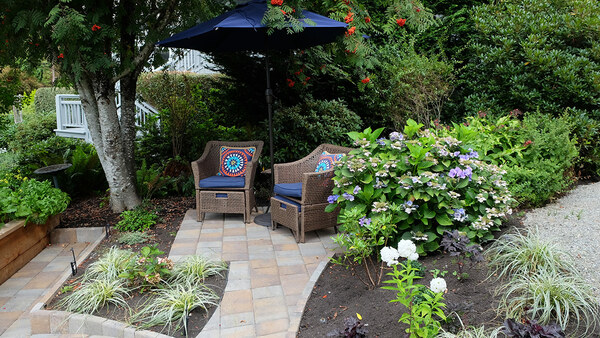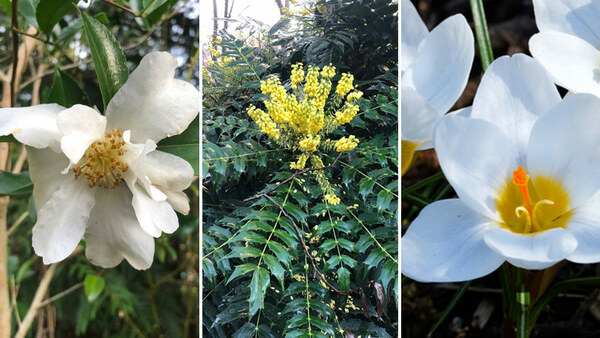
If you’re a sun-loving gardener, finding yourself presented with a woodland garden or an otherwise shaded area of the landscape can feel a little overwhelming, and maybe even disappointing. But as soon as you discover the multitude of wonderful lush and leafy plants that actually prefer to grow in shade here in the Pacific Northwest, you’re going to start wishing you had a few more sun-deficient areas to plant up.
Whether you’re dealing with dappled, partial, or deep shade, there are plenty of shade-loving ground covers, perennials, grasses, ferns, shrubs, and even trees for you to experiment with. Prefer to add some drama? Consider incorporating high-impact plants with big, showy foliage. Not only will they provide texture and color, but lush and leafy plants can anchor the garden, or provide accents or focal points. And often they make the perfect backdrop for flowers or plants sporting a more delicate appearance. You can always add buzz to a shady spot with classics such as hostas or some ferns, but for extra excitement, check out the choices below.
Chilean rhubarb
(Gunnera tinctoria, Zones 7–10)
One of the largest perennials on the planet, this moisture-loving giant make an oversized statement edging streams or ponds or planted directly into bog, rain, or water gardens. Chilean rhubarb is a clump-forming, herbaceous colossus, but it is so fast-growing it rapidly refills its given space every single spring. Each palmate leaf can measure up to 5 feet across and is carried on a huge, sturdy, somewhat spiky stalk that can reach 10 feet tall! Remarkably easy to grow (with shade and water), a single plant gets 10 feet tall and up to 14 feet wide in 5 years. Now you can understand why it’s other common name is “dinosaur food.”
‘Cyclops’ tree houseleek
(Aeonium ‘Cyclops’, Zones 9–11)
Though each individual leaf is not huge, this multitrunked shrubby succulent gives a big, bold, and dramatic impression. It’s one of my personal shade-favoring go-tos, and I knew I had to include it in this list. Reaching up to 4 feet tall and 2 feet wide, with dense rosettes of mahogany leaves on the tips of each fat bare branch (above left), this unusual succulent forms a big bright yellow cone-shaped flowering cluster in early spring (above right). Its color darkens in the sun, but it performs best in afternoon shade unless grown by the coast. It also has minimal water needs.
‘Blue Moon’ princess flower
(Tibouchina organensis ‘Blue Moon’, Zones 9–11)
This rangy, tropical shrub has long, maroon-blushed velvety green leaves, red new spring growth and buds, and stunning, lilac-colored flowers that appear from late spring to fall. The blooms practically glow against the backdrop of the soft, lush foliage. Here in my Northern California garden, afternoon shade is a must (bonus points if this shade does double duty and protects “the princess” from winter frost). With regular water, rich soil, and good drainage this plant will get 4 to 5 feet tall and wide.
White Madera Island geranium
(Geranium maderense ‘Alba’, Zones 9–11)
In its first year in a shade garden, this astonishing giant of a geranium produces large, multilobed leaves (above left) that radiate outward from the thick fleshy base on thick, strong stems. It forms an almost globe-shaped mound measuring 3 feet tall and wide. The following spring, the foliage angles itself downward, and suddenly a gigantic, round inflorescence of beautiful, snowy white blooms appears on top (above right), Madera Island geranium is a biennial, and 5 feet tall and wide in full bloom. It’s not at all fussy about soil or even water but is a generous (not obnoxious) reseeder!
Tips for planting shade plants in an area of heavy root competition
In my own garden, much of the shade is cast by 25-year-old live oak trees, which means acidic soil (because of dropped leaves) and many roots to navigate when adding new plants. In addition, the oak trees want to hog all the water. Here is how I navigate this all-too-common challenge:
- First, I’m careful not to cut through any roots when I dig each hole for new plants.
- Then, I enrich each new planting spot with moisture-retentive compost, being sure to add lime for any acid-averse plants.
- Finally, I direct the irrigation emitters right to the roots of the new plants.
For the thirstiest plants (like Chilean rhubarb), I opt to plant in containers. This allows me to control the soil’s moisture completely.
For more on great shade plants go here.
For more on Pacific Northwest gardening, go here.
—Fionuala Campion is the owner and manager of Cottage Gardens of Petaluma in Petaluma, California.
Photos: Fionuala Campion






















Comments
Log in or create an account to post a comment.
Sign up Log in